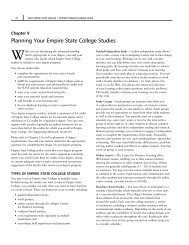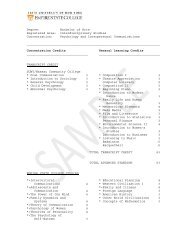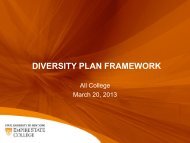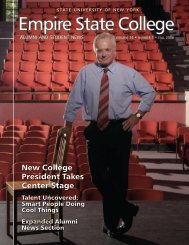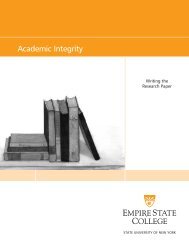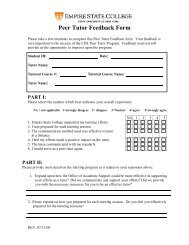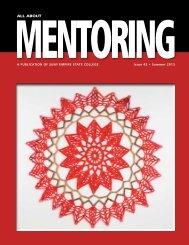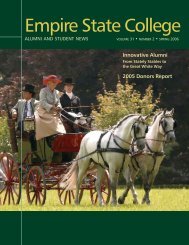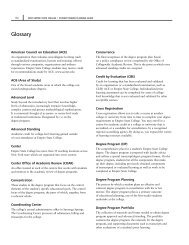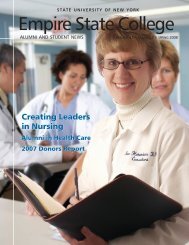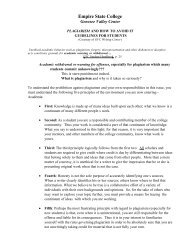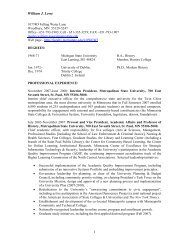Academic Plan 2011-2015 (PDF 524kB) - SUNY Empire State College
Academic Plan 2011-2015 (PDF 524kB) - SUNY Empire State College
Academic Plan 2011-2015 (PDF 524kB) - SUNY Empire State College
You also want an ePaper? Increase the reach of your titles
YUMPU automatically turns print PDFs into web optimized ePapers that Google loves.
<strong>SUNY</strong> <strong>Empire</strong> <strong>State</strong> <strong>College</strong>: <strong>Academic</strong> <strong>Plan</strong> <strong>2011</strong> - <strong>2015</strong> 31Objective B4.5: Support the development of <strong>Empire</strong> <strong>State</strong> <strong>College</strong> genericsThe college needs to provide sufficient resources to maintain the currency of existing genericevaluations and to develop additional “generics” (specific sources of learning that the college itselfhas evaluated). As we develop more partnerships and outreach to companies and organizations,there is an increased need for the college to expand its own inventory of generic evaluations.Generics, if they can be maintained for currency, offer students a more direct path to incorporatePLA within their degree programs. The college also needs to expand its partnerships with othercolleges and organizations which also evaluate learning to provide access to other pre-evaluatedlearning possibilities. Pre-evaluated learning provides effective means to assess student learningin areas that are consistently in demand and provides a recruitment tool targeting students employedin certain industries and occupations.Objective B4.6: Enhance degree program review and approvalIn 2008, the college adopted its current Policy and Procedures for Degree Program and PortfolioReview and Approval, which applies to students’ individual degree program proposals and portfolios.The goals of this policy are to promote quality and consistency with college policy in student degreeprograms and portfolios; ensure timely approval of student degree programs and portfolios; and clarifythe process for students, faculty and staff. The policy was crafted in such a way as to support centerspecificconventions, as the center assessment committee reviews and approves the degree programproposal and portfolio at the center level, on behalf of the college faculty as a whole. Approval bythe committee is required before a degree program proposal and portfolio can be forwarded tothe Office of <strong>College</strong>wide <strong>Academic</strong> Review. The expectation is that committee decisions strive forobjectivity, within the context of the student’s academic and professional goals, college policy andAOS guidelines. The center director of academic review’s role, as a standing member on all centerreview committees, is to promote continuity and consistency in center judgments in relation to collegepolicy. OCAR is responsible for ensuring compliance with college policy and approves the portfolio, atwhich point the degree program plan is concurred and becomes official. Some individual centers alsohave developed various quality review strategies. The degree program also is reviewed at the point ofgraduation recommendation to ensure that the student has met all college academic requirements.Since development and review of an individualized degree program is central to the college’s mission,the college needs to develop ways to assess the extent to which center-specific practices do or do notsupport quality, consistency and timely review.Additionally, there are a range of issues that the college needs to consider at an institutional levelin order to enhance the degree program review process. Each area of study has developed its ownstyle of guidelines, and some are more open-ended than others. There is continued debate on howto interpret these guidelines and whether they are to be interpreted as requirements, guides orsuggestions. The lack of clarity around the purpose and varying interpretation of the guidelines leadsto confusion among students, faculty, the center assessment committees and assessment professionals.The individual and center-based interpretations vary across the college. Additionally, interpretationof the guidelines raises challenges for students and primary mentors in developing degree programsand writing the degree program rationale, even as committees struggle with understanding andinterpreting guidelines, particularly if the student’s area of study falls outside of committee member’sarea of study. In short, the college needs to examine the different practices across the college anddetermine the best way to present and actualize the guidelines to ensure equity and consistency for




